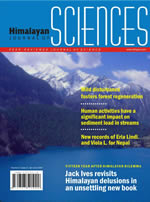Himalayan perceptions: Environmental change and the well-being of mountain peoples
DOI:
https://doi.org/10.3126/hjs.v2i3.224Keywords:
Environmental changeAbstract
Preview of Himalayan perceptions: Environmental change and the well-being of mountain peoples by JD Ives Routledge, London and New York To be published in August 2004 Himalayan Perspectives returns to the enormously popular development paradigm that Ives dubbed the ‘Theory of Himalayan Degradation’. According to this seductive construct, poverty and overpopulation in the Himalayas was leading to degradation of highland forests, erosion, and downstream flooding. In the ‘Himalayan Dilemma’, Ives and Messerli exposed this “Theory” as a dangerous collection of assumptions and misrepresentations. While most scholars in the field promptly conceded Ives and Messerli’s points, the Theory has somehow survived as the guiding myth of development planners and many government agencies. In his new book, Ives returns to drive a stake through the heart of this revenant. His book not only reviews the research that, over the past 15 years, has confirmed the arguments of the ‘Himalayan Dilemma’; it also takes a close look at all those destructive factors that were overlooked by the conveniently simplistic ‘Theory of Himalayan Environmental Degradation’: government mismanagement, oppression of mountain minorities, armed conflict, and inappropriate tourism development. Himalayan Journal of Sciences 2(3): 17-19, 2004 The full text is of this article is available at the Himalayan Journal of Sciences websiteDownloads
Download data is not yet available.
Abstract
1446
PDF
1850
Downloads
How to Cite
Ives, J. D. (2006). Himalayan perceptions: Environmental change and the well-being of mountain peoples. Himalayan Journal of Sciences, 2(3), 17–19. https://doi.org/10.3126/hjs.v2i3.224
Issue
Section
Resource Review




